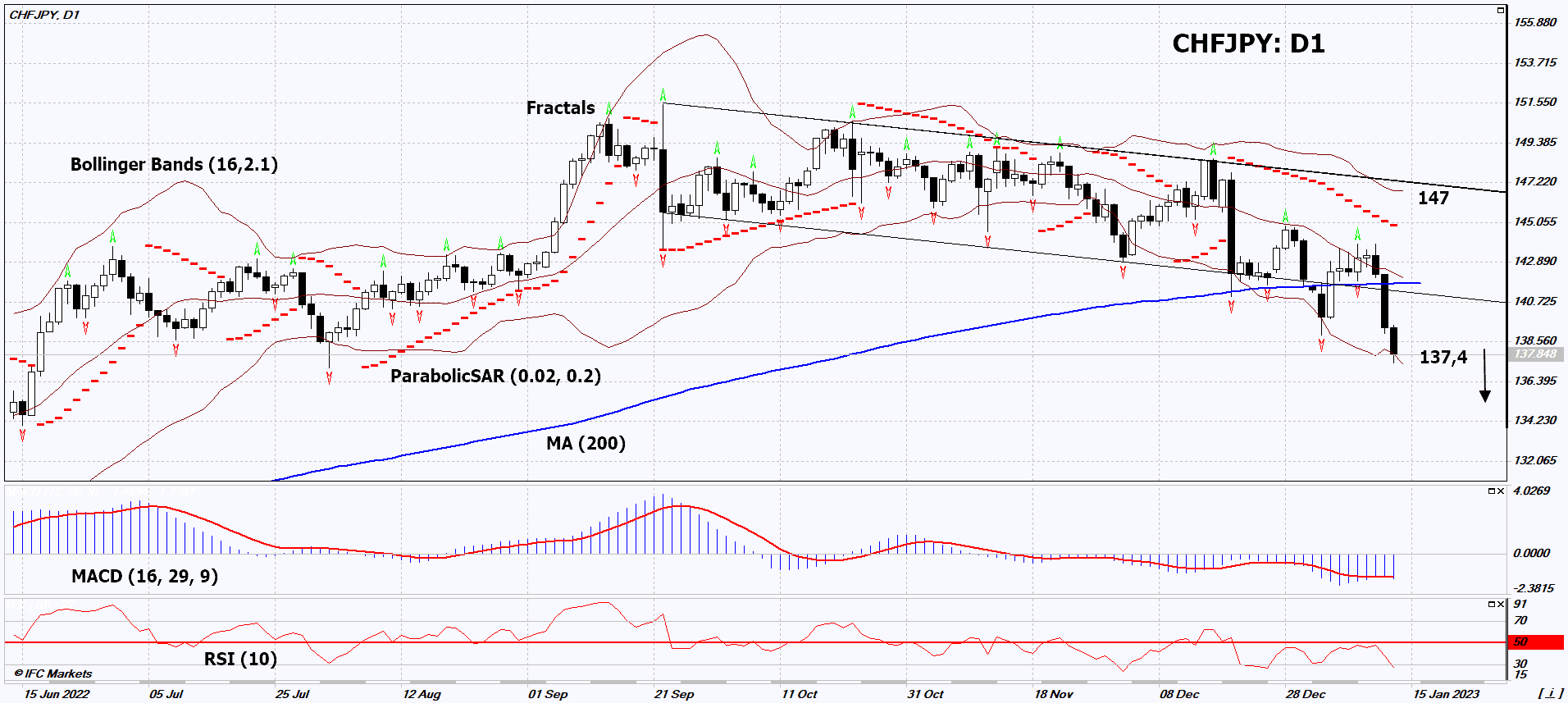- Analytics
- Technical Analysis
CHF JPY Technical Analysis - CHF JPY Trading: 2023-01-16
CHF/JPY Technical Analysis Summary
Below 137,4
Sell Stop
Above 147
Stop Loss
| Indicator | Signal |
| RSI | Neutral |
| MACD | Sell |
| MA(200) | Neutral |
| Fractals | Sell |
| Parabolic SAR | Sell |
| Bollinger Bands | Neutral |
CHF/JPY Chart Analysis
CHF/JPY Technical Analysis
On the daily timeframe, CHFJPY: D1 is in a downtrend and has made a fresh low. A number of technical analysis indicators formed signals for further decline. We do not rule out a bearish movement if CHFJPY: D1 falls below the latest low and lower Bollinger band: 137.4. This level can be used as an entry point. The initial risk limit is possible above the last 2 upper fractals, the upper Bollinger band, the 200-day moving average line and the Parabolic signal: 147. After opening a pending order, we move the stop following the Bollinger and Parabolic signals to the next fractal low. Thus, we change the potential profit/loss ratio in our favor. The most cautious traders, after making a trade, can switch to a four-hour chart and set a stop loss, moving it in the direction of movement. If the price overcomes the stop level (147) without activating the order (137.4), it is recommended to delete the order: there are internal changes in the market that were not taken into account.
Fundamental Analysis of Forex - CHF/JPY
On January 18, 2023, the meeting of the Bank of Japan (BOJ) will take place. Will CHFJPY quotes continue to decline?
Such dynamics means the strengthening of the yen against the Swiss franc. The Japanese newspaper Yomiuri reported that at the next meeting, the BOJ may discuss the effectiveness of its policy on the government bond market (yield curve control policy (YCC). Its actions are viewed by investors as a tightening of monetary policy and contribute to the strengthening of the yen. Recall that at the end of December 2022, the BOJ widened the YCC yield range for the first time, pushing the Japan 10-Year Bond yield up from 0.25% to 0.5% per annum and appreciably strengthening the yen. According to the results of 2022, Swiss National Bank does not exclude the maximum loss in 116 years. It could reach 132 billion Swiss francs ($143 billion). This may have a negative impact on the Swiss franc. It should be noted that on January 19 in Japan the trade balance will be released, and on January 20th inflation data will be released. In Switzerland, on January 19 will be published producer price index.
Explore our
Trading Conditions
- Spreads from 0.0 pip
- 30,000+ Trading Instruments
- Instant Execution
Ready to Trade?
Open Account Note:
This overview has an informative and tutorial character and is published for free. All the data, included in the overview, are received from public sources, recognized as more or less reliable. Moreover, there is no guarantee that the indicated information is full and precise. Overviews are not updated. The whole information in each overview, including opinion, indicators, charts and anything else, is provided only for familiarization purposes and is not financial advice or а recommendation. The whole text and its any part, as well as the charts cannot be considered as an offer to make a deal with any asset. IFC Markets and its employees under any circumstances are not liable for any action taken by someone else during or after reading the overview.

